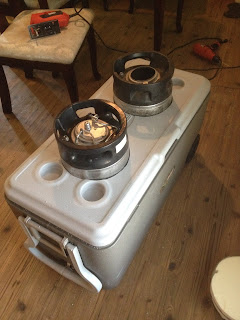WE DID IT!
Many of you have probably heard from our many facebook posts that our Russian Imperial Stout won the silver medal in its category at Deep Ellum's Labor of Love Homebrew Competition and Festival. Our first hardware! The judges score sheets commended the balance achieved between a large malt presence and just the right amount of bitterness to keep the finish somewhat dry. We are very happy with the results, and Amanda has advised that we brew this year-round to keep up a steady supply.
 |
| Judges' Comments |
The festival was tons of fun. We want to thank everyone who stopped by and sampled our beer. We brought our Palo Alto Wit and a clone of Weihenstephan Hefeweissbier that we dubbed Hurricane Hefe (to keep with our nautilus-inspired spiral mantra), and a few bottles of the stout. We thought no one would want to drink stout when it's 100 degrees out, but we ran out of stout within the first hour! Everyone saw our medal and wanted a taste.
 |
| Beerhemoth in action! |
The beerhemoth performed beautifully. After setting up at 3pm and packing out at about 10:30, there was still plenty of ice around each keg. The beer coming out of each tap was just the right temperature, and a lot of the foaming issues other folks had using standard jockey boxes did not rear their ugly heads for us. The hefeweizen was a little over-carbonated, which isn't a terrible thing for the style, but we were able to pour the perfect sample by dispensing into a small pitcher before pouring each taste. This is a standard trick of the trade for beers with high carbonation (into the 3.0+ volumes realm).
 |
| Our "menu" |
We had a great time sampling everyone else's homebrew. I want to give a shout out to Steel Rain Brewing to congratulate them on the GOLD medal they won for their Saison. Seriously, that was an amazing Saison. Easily the best I've ever tasted. Great job, y'all! We should collaborate one of these Aggie game days and brew up something good.
We also had the opportunity to pour our homebrew for fellow Arlingtonians at the #CreateArlington Pop Up Art & Music Festival this past weekend. We met tons of great folks who had very kind remarks on our beers. We brought what was left of the Hefe, the Wit, a few bottles of RIS (those are starting to get scarce!), and the pale ale we brewed for our friend's bachelor party this summer. We had several folks who were self-proclaimed "not beer people" comment on how they could actually taste this stuff and that they really liked it. We met a nice young family who had recently returned to North Texas from a few years living in Houston, and they were relieved at the advances in the craft beer scene in the time they had been away. We even had a few globe-trotting beer fans tell us the hefeweizen tasted just like the German wheat beer they remember from their trip across the pond. Everywhere we pour, we're just as excited to talk beer as people seem eager to try it!
Many fine folks asked how they could get a hold of New Main homebrew at the Pop Up Festival. Unfortunately, TABC laws prohibit the sale of homebrew unless I obtain a manufacturer's license. While a commercial venture may be some time off in the future, we are planning on producing some cool New Main gear for both homebrewers and craft beer fans alike very soon. In the mean time, if you happen to be in the neighborhood on a brew day, I'll be happy to pour you some homebrew and talk beer with you.
We want to thank everyone who has supported us thus far. In all honesty, the thing I love most about homebrewing is sharing beer and memories with all of you. You make all the hours of hard work in my precious free time worth it with every sip and each read. Thank you all for being excellent beer fans!












